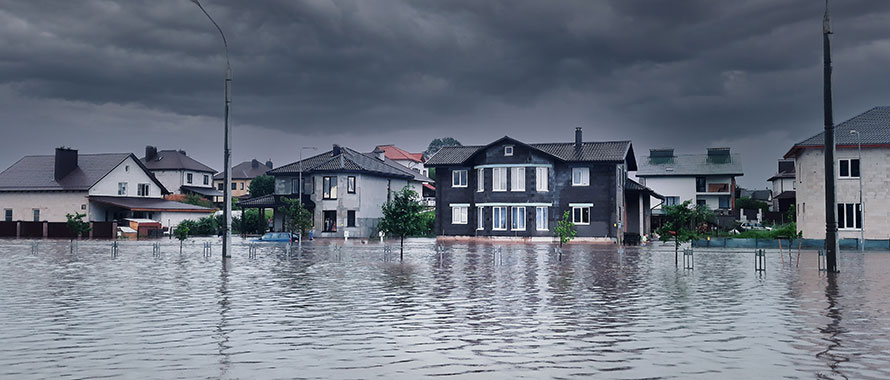A new flood-risk rating system went into effect April 1 for all National Flood Insurance Program (NFIP) policy renewals, moving the U.S. government-backed Flood Insurance program to a method of determining premiums that is expected to be more precise and equitable. According to FEMA, the Risk Rating 2.0 system uses industry best practices and the latest technology to provide rates that “better reflect a property’s flood risk.”
Already launched on Oct. 1 for new policies, the rating system marks a significant shift for the NFIP, said Brad Turner, Associate Vice President, National Product Manager, Flood, Burns & Wilcox, Morehead City, North Carolina.
Featured Solutions
The changes come at a time when many homeowners face an increased risk of experiencing natural disasters due to the impact of climate change, making Flood Insurance even more critical.

It is the biggest change for the NFIP since the inception of the program. … This is shifting from basic criteria to a more sophisticated approach that is location-specific.
“Storms are getting more severe and we are seeing more large events,” said Jacob Martin, Underwriting Manager, Flood, Burns & Wilcox, Charlotte, North Carolina. “So many major flooding events have happened over the past 20 years or so and it is only going to continue to escalate if what the climatologists are saying is correct.”
Rate increases, capped at 18% per year, expected for many homeowners
Managed by FEMA, the NFIP insures properties in 23,000 participating communities and has long based its rates on static measurements including a property’s elevation within certain zones. The new system incorporates more flood risk variables, including frequency, flood types, distance to a water source, property characteristics and rebuilding costs, according to FEMA.
“Two big changes will push the rates,” Martin explained. “They are now taking into consideration coastal surge exposure, and they are also considering the replacement cost of the building. Until now, you could have a $5 million house and be rated the same as someone with a $250,000 house. That is just not the same exposure at all.”
While maximum limits for a home will remain at $250,000 for the building and $100,000 for contents, weighing rebuilding costs will more equitably distribute premiums based on the individual home’s exposure, FEMA noted. “If there is a flood that covers the first 3 feet of the building, you are going to exhaust your limits a lot faster on the $5 million house than a $250,000 house,” Martin said.

Two big changes will push the rates. They are now taking into consideration coastal surge exposure, and they are also considering the replacement cost of the building.
The changes are likely to bring significant rate hikes for many property owners, particularly those with high-value homes or homes in coastal areas, Turner said. These increases will be capped at 18% per year for existing policyholders, and it could take many years for some properties to see the full increase.
“Most individuals are not going to see a large increase all at once,” Martin added. “If the policy is $500 and should be $9,000, it is going to take a lot of 18% increases before you ever get there.”
While some homeowners could see their rates go down under the new system, the very low rates that some lower-risk properties have been priced at in recent years may not last long. In 2020, FEMA noted that about 25% of all Flood Insurance claims were in areas considered at low-to-moderate flood risk.
“A lot of losses happen in these low-risk areas, and we have seen rates go up drastically in those segments based how the exposure compares to the flat pricing seen with the NFIP previously,” Turner said. “The market price is expected to escalate overall, but much of these ‘safer’ areas will also see the pricing driven up as well.”
Uninsured loss can be ‘life-changing’ for homeowners
Standard Homeowners Insurance policies do not cover flood losses — a fact that many homeowners may overlook when purchasing Homeowners Insurance for the first time, particularly if the coverage is not required by their mortgage lender. “A lot of individuals are not aware that their Homeowners Insurance does not cover flood, or their home is paid off so they do not carry the insurance because they are not required to,” Turner said.
While not everyone is in a highly flood-exposed area, such as those elevated above the water line, “for a lot of individuals, that is not the case,” Martin said. “It is important for those individuals to protect themselves with Flood Insurance.
According to FEMA, just one inch of flooding in a home can cause damage costing over $26,000.

It is devastating, difficult to recover from, and can displace people for a year or longer in some circumstances. Attempting to recuperate or rebuild without insurance present becomes a life-changing event for a lot of individuals.
“Realistically, it is probably going to be more than one inch of flooding,” Turner said. “With many coastal events, surge waters can exceed 10 or more feet from the ground level and these waters can move away from the coast upwards of 50 miles through adjacent waterways. If it is not an elevated home, it can be catastrophic to the structure and contents. Frequently, claims exceed $60,000 for an average dwelling in coastal segments and those proximate to a nearby flooding source. For high-value homes and commercial properties, the loss magnitude is increased drastically, with a high likelihood of exhausting the full NFIP policy limits.”
Flood Insurance in the U.S. is the number-one underinsured or uninsured risk, Turner pointed out. “It is devastating, difficult to recover from, and can displace people for a year or longer in some circumstances,” he said. “Attempting to recuperate or rebuild without insurance present becomes a life-changing event for a lot of individuals.”
New system could lead to more competition with private Flood Insurance
Beyond the NFIP, Flood Insurance is also available through private insurance carriers. These policies can offer a range of coverages that are not available with NFIP policies, including higher limits and indirect loss coverage, such as loss of use and additional living expenses. For commercial properties, loss of business income coverage may also be available on private Flood Insurance policies, Turner said.
Private Flood Insurance can also offer coverage for personal property in a basement, detached structures outside of the dwelling, pool repair and refill, and landscaping.
“All Flood Insurance at its core level should be as broad as the NFIP coverage form, but there are many exclusions and modifiers that exist within the NFIP language,” he said. “There are opportunities to supplement within these coverages that do not exist within the NFIP.”
Excess Flood Insurance limits are an important consideration for those with higher-value homes, Martin added. “If someone has a $2 million or $3 million home, we could offer something to get them up to full coverage,” he said. “With the private market, there is a lot more available coverage than what the NFIP will offer.”
In light of the changes brought by Risk Rating 2.0, more homeowners may choose to seek out private Flood Insurance quotes, Martin said. “This presents a lot of opportunity for the private Flood Insurance market,” he said. “Individuals are going to be shopping their insurance with private Flood Insurance, and I would encourage them to see if the private market can offer better coverage.”
That competition can give homeowners the chance to find the best coverage at the best price, Turner said. “I expect property owners to begin shopping specific coverage options across a variety of carriers. Competition should provide the consumer an opportunity for increased value from their policy, including a more favorable price,” he said. “We have seen an exponential increase in quoting frequency since these market changes have transitioned and expect that trend to continue.”
Understanding your flood risk
When shopping for Flood Insurance, it is important for homeowners to understand their individual risk. For example, older homes may not have been built to sustain a flood event. “These homes have traditionally had fewer mitigation features, including proper elevations and preventative risk management characteristics. These older homes do not usually have physical surveys available and were not built with flood risk in mind due to the community NFIP participation at the time of construction,” Turner explained. “They tend to be heavily exposed, and in general, these properties are being held accountable for the increased risk compared to the premium being charged traditionally through the NFIP.”

With the private market, there is a lot more available coverage than what the NFIP will offer.
If a homeowner has concerns that the change in their Flood Insurance premium is not accurate, they may want to consider having a physical survey done on their home to obtain an elevation certificate.
“The technology being utilized gives unprecedented insight on flood risk, however, there are cases where elevation discrepancies of a foot or two can greatly affect the premium,” he said. “Even though [a physical survey] is not required anymore, it could be advised in some situations to help with the premium.”
An experienced Flood Insurance broker can guide homeowners through these considerations. “Flood coverage is not something that many retail brokers specialize, so having someone who can explain the different coverages and what is excluded under a policy is certainly important so there are no surprises when a claim happens,” Martin said.
Brokers who work exclusively in this market “are more aware of the nuances of Flood Insurance and how to navigate those,” Turner said. “It is always good to partner with somebody that specializes in it,” he said.
Despite debate over the NFIP risk rating changes, homeowners will ultimately have access to a truer gauge of their individual flood risk. “An encouraging result of this change is that pricing is being driven to more accurately represent risk at the location-level and in-turn inform the insured of expectancy. It is something we have evaluated for years within the private market, and these tools have become progressively more informative,” Turner said. “There are many resources available now, including on a consumer level, where people can gauge their exposure. Being able to make an educated decision is a good thing for a consumer, especially with Flood Insurance.”






